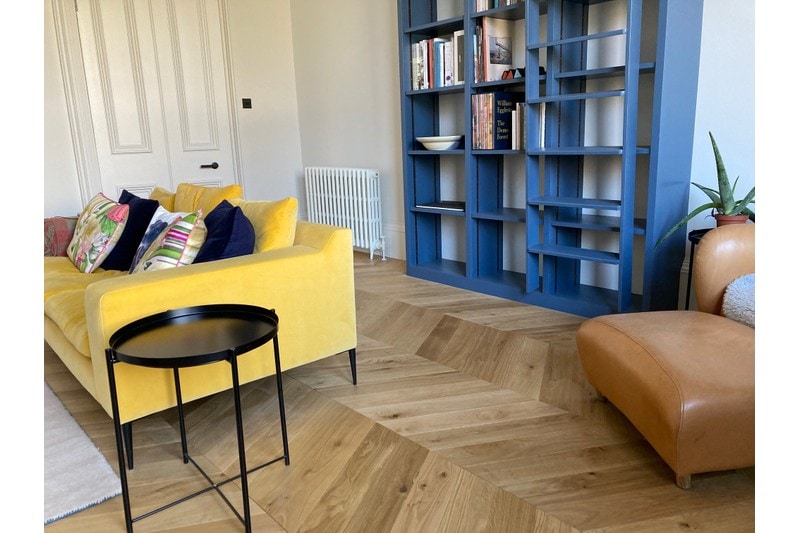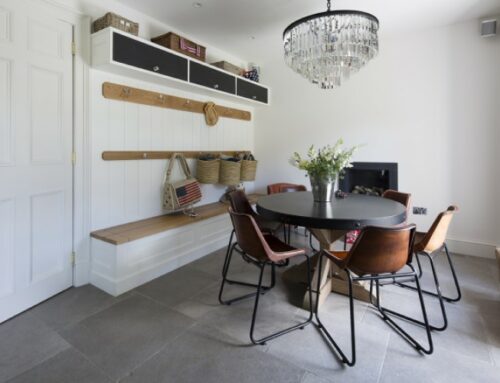You are probably reading this article because lots of people will be telling you what kind of oak floor would be best for you. Well, lets put the power of that decision back to you by reading this article.
An important starting point is to explain what engineered oak flooring is and what solid oak flooring is.
What is engineered oak flooring?
Engineered Oak flooring firstly should not be confused with laminate flooring. Laminate flooring typically has an HDF core (High-Density Fibreboard) and is between 6 to 12mm thick. It has a printed wood-effect paper on the top to make it look like the real thing.
Engineered Oak flooring is a manufactured form of oak flooring that has layers of different materials sandwiched (engineered) together. The top layer, also known as wear layer, of the flooring is real solid oak, and is typically between 3mm-6mm thick. Below the wear layer, the cross-layer core provides the strength and stability that your flooring needs. Various materials can be used in the core layer but they are usually plywood or softwood. This inner core is what makes engineered oak flooring very stable, more so than solid oak flooring.
What is solid oak flooring?
Solid oak flooring is exactly as it sounds; flooring that is made from a solid piece of oak, oak that is cut from the tree trunk and then dried, machined and sanded into planks, parquet blocks etc.
Solid wood flooring is now in decline. This is due to increased awareness of sustainability and the need to reduce deforestation, and to changes in the market (such as the increased use of underfloor heating).
Which is more stable?
Engineered Oak flooring is a more stable floor – Wood, such as oak, is a natural material that is susceptible to atmospheric and moisture conditions. As a result, changes to the atmospheric temperature and moisture content of the space will mean the planks/parquet blocks will expand and contract. Due to the construction of engineered oak floors, this expansion and contraction is significantly reduced (though not completely).
Solid Oak flooring will more likely expand and contract, meaning it can buckle, crown, lift and cause squeaks in the floor.
Which one is compatible with underfloor heating?
Engineered oak flooring is suitable with underfloor heating (wet and electric systems), and solid oak flooring is not. The construction of engineered oak flooring allows for the floor to naturally expand and contract without it warping, cracking or twisting as can be the case with a solid oak floor.
Oak flooring is naturally warmer underfoot than a tile, so you may find that if you opt for an oak floor you may not need the warmth of the underfloor heating underfoot. So, if you have your heart set on solid oak, you may decide to ditch the underfloor heating.
Which has more style options?
Engineered oak flooring will have more style options available. These style options include, wide planks, extra-wide planks, various parquet block sizes, chevron parquet and cassette designs. With a vast choice of prefinished engineered oak flooring options, you will be spoilt for choice. Take a look at our Express Collection and Choice Collection of prefinished engineered oak flooring for inspiration. There is a much smaller choice of prefinished options if you were to opt for solid oak flooring, and often you will find that solid oak flooring is only available as unfinished (requiring finishing upon installation).
Solid Oak flooring is typically available in plank form (usually in narrow widths and shorter planks) and small block herringbone (such as our Unfinished Solid Herringbone Square Edge oak).
Which will last longer?
Solid oak flooring can be refinished multiple times, however, it all depends on what engineered flooring you are comparing it to. Solid is often perceived as the better product than engineered because it’s solid oak from top to bottom. ‘I can sand it down more often’ or ‘It will last longer’ are often-heard statements.
The important thing to note here is that you will be limited to the look of the floor you can choose should you wish to refinish/sand your floor back multiple times. For example, if you choose a prefinished oak floor that has had specialist oils applied and a brushed finish, and if you sand this back, you will lose the look of the floor – essentially you are stripping it back to the original oak.
As a rough estimate, the expected lifespans for engineered and solid oak floors are:
Average lifespan of an engineered oak floor – 20 – 30 years
Average lifespan of a solid oak floor – 30 – 50 years
This of course is a very rough guide, and there are many factors at play that can affect the lifespan of a floor such as following the correct maintenance and care guidelines of your oak floor.
Which is better to install?
Engineered wood flooring can be glued down (recommended method for underfloor heating), nailed down (if over a timber subfloor), or laid over an underlay and ‘floated’. Again, expansion gaps must be considered around the perimeter although you can go a bit further with engineered due to its stability, for example you can fit the floor closer to skirting boards, walls etc. In addition, you can avoid using beading, and use a colour matching gap filler instead which is a much cleaner and less fussy finish.
Solid wood flooring is either glued down or nailed down (if over a timber subfloor). A larger expansion gap must be considered around the perimeter compared to the installation of an engineered oak floor.
From a joiner’s perspective, engineered oak flooring tends to be easier to work with and less harsh on their tools such as blades, which will be accounted for in their quotation to you.
Summary
Solid and engineered oak floors are both excellent choices if you want a real wood floor that will last for decades.
However, there are some limitations with solid oak flooring such as how it can be laid (it cannot be floated), it can be more vulnerable to temperature changes (meaning that it may be more likely to cup, warp and/or gap), and the plank lengths are usually much shorter (due to stability and product availability).
Whereas, engineered flooring has all the benefits of solid oak flooring, plus many more (such as being very durable, suitable for underfloor heating and available in a range of widths/lengths). In fact, the only real downfall with engineered flooring is that generally, you can refinish a solid wood floor more than engineered, however, if you look after your engineered wood floor well and follow maintenance advice, then you shouldn’t need to sand it down too often or ever.
Therefore, the choice is completely yours and you should make the decision based on what is right for you and your requirements. But have peace of mind that both are long-lasting flooring solutions that will add beauty and charm to any room.
Looking for a bit of inspiration? Check out our oak flooring collections, which includes both engineered and solid oak flooring options; https://www.stoneandtimber.co.uk/engineered-oak-flooring/
Need a little more help? We love talking about oak flooring (we could do it all day long if you let us), and we would be delighted to advise you on your project. Get in touch today, by phone 01764 684 836 or email info@stoneandtimber.co.uk









